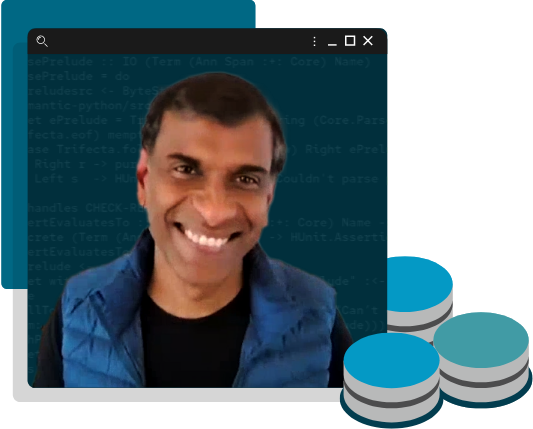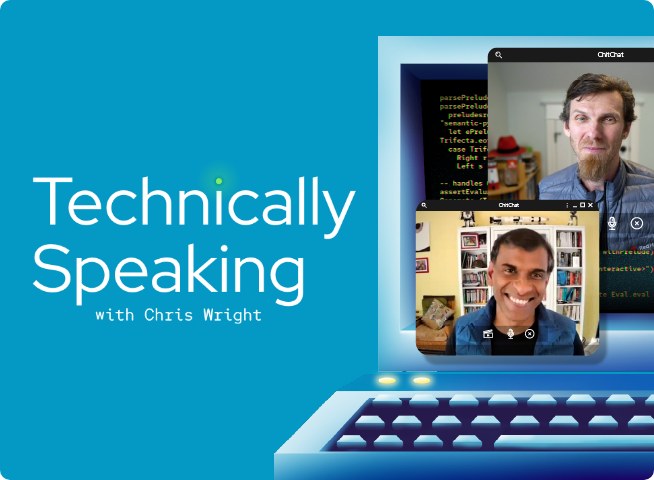A Vested Interest in 5G
Network upgrades come and go, so why is 5G a big deal? In this episode, Srini Kalapala, Vice President of Technology and Supplier Strategy at Verizon, joins Red Hat CTO Chris Wright to talk about what makes 5G different from previous networks and explains the role open source has played in the development of the network and its potential for the future of the telco ecosystem. Plus, if fashionable vest wear makes you want to break out into song, this is the episode for you.
...It supervises the laying of underwater cables that enable people to call across the seas.
Could Alexander Graham Bell fathom how his invention would drive the creation of telephone exchanges, transatlantic lines, the advent of first, domestic area codes, then international country codes? If history has taught us anything, we can't know what's around the bend but the decisions we make now are key to the possibilities in the future.
00:31 — INTRO ANIMATION
Think about it, the telephone was invented 145 years ago and today, we have something called 5G. 5G represents the fifth generation of mobile cellular data networks. When you look at past mobile networks, each evolution made incremental improvements to ensure a good experience to customers. First, it was about delivering wide service coverage with 1G, which was entirely analog. Then 2G networks went digital and we developed SMS messaging. 3G and 4G marked an explosion in data services and the rise of the smartphone. Each previous generation was focused on developing that one experience, much better than the generation that came before. But 5G isn't just about human connectivity, it's about broad connectivity, including machines, which unleashes a whole new set of use cases. I want to dig into the details with someone who spends a lot of time thinking about 5G networks and industry-changing technology.
Hey Srini, it's great to see. I'm really excited about having a chance to talk to you about 5G networks. How are you doing?
Good, good, how are you Chris?
You know, it's wintertime here, so had to put my vest on. Looking good, but let me just jump into 5G. So, 5G is really changing what, how we define the infrastructure for networks. And we've got some key characteristics. We've got higher bandwidth, we've got lower latency, we've got denser connectivity or more devices potentially connected to networks. All of this comes together to create pressure on you to build a network and deliver these capabilities. So, I'd like to understand, tell me a little bit about the challenges that you're hitting as you move into this software defined, kind of, Cloud native world for building networks?
It's a network built not only for humans, but machines, you know, connecting all the future technologies and the future machines that are going to be either driving autonomously in whatever way. What that requires is that we need to, the networks need to get very close to the kind of applications that are being served by these networks. So the fundamental difference from the previous generations to now is, we no longer get these physical, highly integrated function specific boxes. Now we deploy cloud infrastructure. And then on top of that, we now deploy applications where we want them, when we want them and in whatever scale that we want that. That's the fundamental shift in the way we are building and managing networks in the world of 5G.
Virtual machines to containers creates additional complexity because, you know, maybe you had four VMs and now you have 16 containers and it's more complex. But at the same time we're introducing automation to manage that complexity which gives you the ability to focus on the value that you're creating in your network. I think there's another interesting aspect here, which is it's not just you, I mean, we're there helping you build this, but we're not doing it alone. There's, there's an entire ecosystem. How do you see that the evolution of the ecosystem helping you build this next-generation network?
You touched on a point. As you are taking on more burden of making sure, you know the containers can be orchestrated on the CAS stack. And if you take their burden, for my engineers, that less burden to worry about. For our Verizon engineers, it is now, you know, how do you create these next-gen services and you know, next-gen experiences? So, we look to the ecosystem to really take away and deal with all the lower-level integration.
So we're moving from that well-integrated, sort of, vertically integrated stack to something that's dis-aggregated, but sort of reintegrated through some combination of defacto standardization, best practices and real industry standards. I think one of the key aspects in that, in that transition how we enable that, that new model of working, is leveraging open-source communities. The ability to be open and collaborate across ecosystems is a game changer. How does open source factor into your strategy? Where are you leveraging open source and in building your network and influencing the ecosystem?
We use open source as a way to accelerate the shift to some of the newer architectures and newer platforms. Where open source helps is, you know I'll give an example of, you know we've been IPv6 and we needed a stack that can actually, as we shipped with Cloud native and what relation that can support IPv6. So we see that there is a rapid adoption of some of these changes by working through the open source because everybody is a member of that. And then that change workloads down into all the suppliers areas. And then, you know then, you know it hits us with less trouble. I would say, we, we get it on time and with better quality.
It's that broad ecosystem common effort that I think resembles kind of, a common language of how we communicate with each other, that that's a way that that's establishing these, these new norms for the industry. In my mind that is evolving the industry, is that similar to how you see it? Or should I look at it a different way?
It is evolving in the same and if you look back historically, this industry has been a very closed industry. Telecom suppliers have been, you know, delivering very- We had many, many suppliers in 20, 30 years ago and all the years that supplier in a landscape has shrunk and you have fewer now and they've been delivering these very siloed functions that become extremely complex to interoperate between them. But as we shift to this future world where we have to deliver lot many more capabilities, because that's where the demand is. And in that world, the custom stack development would not scale, would not deliver us the speed and agility we're looking for. We're seeing the shift where everybody prefers this common definition, common denominator, so that they can then bring in their own specialties on top of that.
5G creates all these new opportunities. It's not just about the human connectivity that we talked about earlier, it's including the machine-to-machine connectivity which is building new business opportunities.
We know that by combining these new, you know, experiences the unique experiences with cloud at the right place for the user, we can deliver even better outcomes.
Thanks so much Srini for joining today. I wish we could go for another hour. It's such a fascinating topic.
Thanks Chris, this was a very interesting conversation. We got to have more of these.
The 5G revolution is not just your run-of-the-mill hardware IT refresh. It's a fundamental shift that drives a tremendous amount of change. It's not just about human connectivity, but delivers faster more reliable machine-to-machine connectivity, which, combined with the cloud creates the mobile edge. And it's really poised to become the foundation for next generation software solutions that will fundamentally change how we live our daily lives.
08:18 — OUTRO ANIMATION
- Keywords:
- Edge
Meet the guest

Srini Kalapala
Vice President of Technology and Supplier Strategy
Verizon
Keep exploring
Understanding edge computing for telecommunications
Adopting edge computing is a high priority for many telecommunications service providers as they modernize their networks and seek new sources of revenue.
Read the articleOpen networks transform industries
As 5G becomes mainstream, the rate of transformation is accelerating. An open source approach—supported by a robust, certified ecosystem—gives service providers the flexibility to meet their customers' demands.
See Red Hat’s telecommunications approachMore like this

Technically Speaking: Edge Computing Covered and Diced
Edge computing is an onion. What happens when you peel back the layers and uncover the implications of 5G and lower latency?

Rethinking Networks in Telecommunications
Successful telecommunications isn't just the speed of a network. Tech Mahindra's Sandeep Sharma explains how companies can keep pace with unforeseen changes and customer expectations.

What Can Video Games Teach Us about Edge Computing?
Edge computing could be a boon for areas of the world with poor internet connectivity. But how does it really work, and what are its possible uses and implications?
Share our shows
We are working hard to bring you new stories, ideas, and insights. Reach out to us on social media, use our show hashtags, and follow us for updates and announcements.
Presented by Red Hat
Sharing knowledge has defined Red Hat from the beginning–ever since co-founder Marc Ewing became known as “the helpful guy in the red hat.” Head over to the Red Hat Blog for expert insights and epic stories from the world of enterprise tech.
